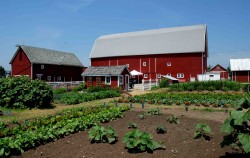**Our 2014 Winter Meeting was canceled due to inclement weather, but the NBA is trying to partner with BCCC once again in 2015! This time around, the meeting will take place on February 21-22, 2015.
This guest post comes from Patricia Fisher-Olsen, Coordinator of the Historic Preservation Program and lecturer at Bucks County Community College (BCCC) in eastern Pennsylvania. This year BCCC has agreed to host the NBA’s Winter Meeting at their 200-acre Newtown campus where several of the school’s NRHP-listed buildings have been re-adapted to serve as classrooms – enhancing the learning environment for all its visitors! From 11:30 am to 1:30 pm, Saturday, February 15th, the NBA’s Winter Meeting is open to the public. We encourage any barn enthusiasts in the vicinity to join us as we learn more about barns in the region and what all the students at BCCC are doing to save them! The lecturers are free though small donations to help cover the cost of lunch are welcome.
In 1991, BCCC became the first school in the country to offer a 24-credit Certificate Program in Historic Preservation and since then the campus program has grown and expanded online, offering students the unique opportunity to complete their Historic Preservation Certificate entirely over the Internet. Students opting to take courses on our Newtown campus will find them immersed in a working preservation laboratory. Classes and lectures are taught in buildings listed on the National Register of Historic Places, surrounded by historic landscapes and formal gardens. Students opting to take courses through our online campus will find themselves immersed in the preservation laboratory of their own communities. The online courses are designed to leverage the historic resources in all areas of the country.
In 2008, Bucks students won the coveted National Parks Service/American Institute of Architects’ Charles E. Peterson Prize, which annually recognizes the best set of measured drawings prepared to Historic American Building Survey (HABS) standards by college or university students. At BCCC, the HABS program operates as part of the institution’s Historic Preservation Department. The program offers students the opportunity to measure and record the architectural details of historic structures as they exist today, before they are further altered by time, nature and people. By studying clues, such as the changes in mortar and other materials applied to a structure, HABS students document both a building’s history and the history of the people who made the changes.
Since 1991, Bucks County Community College faculty member, Kathryn Auerbach, has led several teams of HABS students as they measured and documented historic structures here in Bucks County and across the country. The recorded findings of the students, many of whom have no previous architectural or building experience, have become part of the collection at the Library of Congress to be used for future research. The college competes for the best architectural measured drawings of a historic American structure in the Charles E. Peterson HABS Prize Competition sponsored by the National Park Service, the American Institute of Architects and the Library of Congress.
The yearly contest is highly competitive, with entries from architecture and design programs at nationally recognized universities. Several of BCCC subsequent HABS classes have gone on to secure a Honorable Mention, 4th place, 3rd place and even 1st place in the competition. In 2008, BCCC – the only community college entrant – won a highly coveted 1st place award for their work with the National Park Service on the Best Farm Stone Barn, located on the Monocacy Battlefield in Frederick, Maryland.
In Bucks County during the 1930’s, many of the HABS projects involved old stone barns that were very prevalent in this part of the country. Today, thirty percent of the barns that were documented no longer exist. Without the HABS sets of measured drawings and photographs, no evidence would exist of some of Bucks County’s beautiful stone barns, nor of the people who built and used them.
Students who participate in the HABS class at BCCC not only learn about historic architecture but also develop important problem-solving skills. Many of our HABS drawings will be on display during the National Barn Alliance Winter Meeting.













